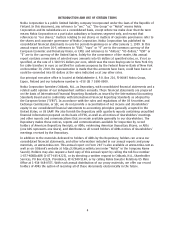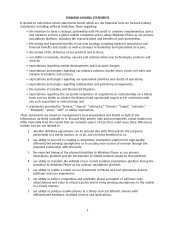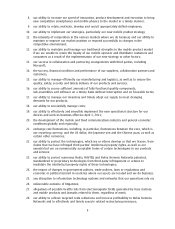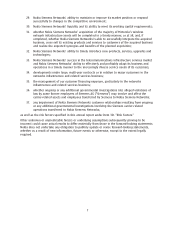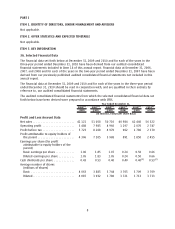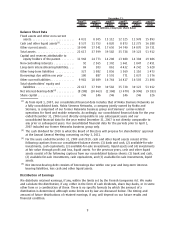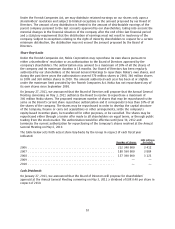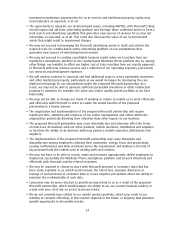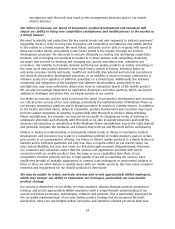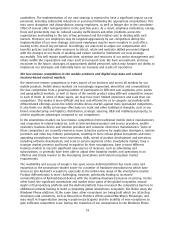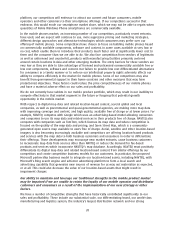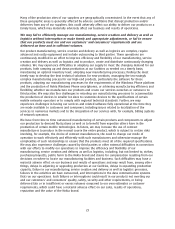Nokia 2010 Annual Report Download - page 14
Download and view the complete annual report
Please find page 14 of the 2010 Nokia annual report below. You can navigate through the pages in the report by either clicking on the pages listed below, or by using the keyword search tool below to find specific information within the annual report.to differentiating Nokia smartphones from those of our competitors who also use the Windows Phone
platform. The Microsoft partnership would also provide opportunities for new revenue sources from
the combination of various services, such as our locationbased assets with Microsoft’s broader search
engine and advertising platform.
While we transition to Windows Phone as our primary smartphone platform, we will continue to
leverage our investment in Symbian for the benefit of Nokia, our customers and consumers, as well
as developers. This strategy recognizes the opportunity to retain and transition the installed base of
approximately 200 million Symbian owners to Nokia Windows Phone smartphones over time. We
expect to sell approximately 150 million more Symbian devices in the years to come, supported by
our plan to deliver additional user interface and hardware enhancements. We will continue our
development of MeeGo with increased emphasis on longerterm market exploration of next
generation devices, platforms and user experiences. We expect the transition to Windows Phone as
our primary smartphone platform to take about two years. We and Microsoft have entered into a
nonbinding term sheet, and the proposed Microsoft partnership remains subject to the negotiation
and execution of definitive agreements. See Item 4B. “Business Overview—Devices & Services—New
strategy—Smartphones” for additional information about the proposed Microsoft partnership.
Our proposed partnership with Microsoft and change in our smartphone platform strategy are subject
to certain risks and uncertainties, which could, either individually or together, significantly impair our
ability to compete effectively in the smartphone market. If that were to occur, our business would
become more dependent on sales in the mobile phones market, which is an increasingly
commoditized and intensely competitive market, with substantially lower growth potential, prices
and profitability compared to the smartphone market. Those risks and uncertainties include the
following:
• Definitive agreements with Microsoft for the proposed partnership may not be entered into in
a timely manner, or at all, or on terms beneficial to us.
• In choosing to adopt Windows Phone as our primary smartphone platform, we may forgo
more competitive alternatives achieving greater and faster acceptance in the smartphone
market. If we fail to finalize our partnership with Microsoft or the benefits of that partnership
do not materialize as expected, we will have limited our options and more competitive
alternatives may not be available to us in a timely manner, or at all.
• The Windows Phone platform is a very recent, largely unproven addition to the market focused
solely on highend smartphones with currently very low adoption and consumer awareness
relative to the Android and Apple platforms, and the proposed Microsoft partnership may not
succeed in developing it into a sufficiently broad competitive smartphone platform.
• Our expected transition to the Windows Phone platform may prove to be too long to compete
effectively in the smartphone market longer term given the ongoing developments of other
competing smartphone platforms.
• Our ability to innovate and customize on the Windows Phone platform may not materialize as
expected to enable us to produce smartphones that are differentiated from those of our
competitors.
• The Microsoft partnership may not achieve in a timely manner the necessary scale, product
breadth, geographical reach and localization to be sufficiently competitive in the smartphone
market.
• The Microsoft partnership may erode our brand identity in markets where we are strong and
may not enhance our brand identity in markets where we are weak. For example, our
association with the Microsoft brand may impair our current strong market position in China
and may not accelerate our access to a broader market in the United States.
• New sources of revenue expected to be generated from the Microsoft partnership, such as
13



